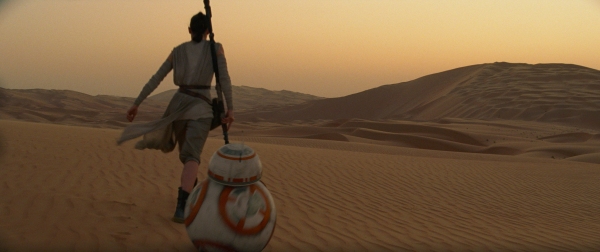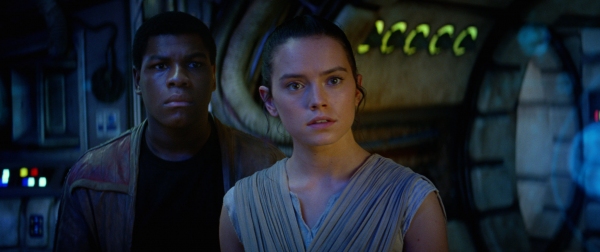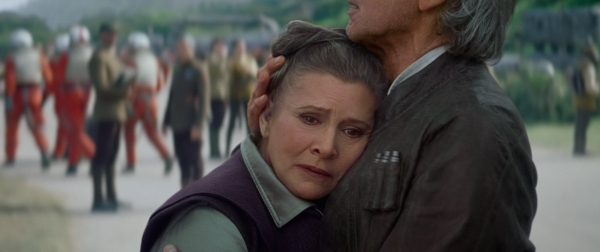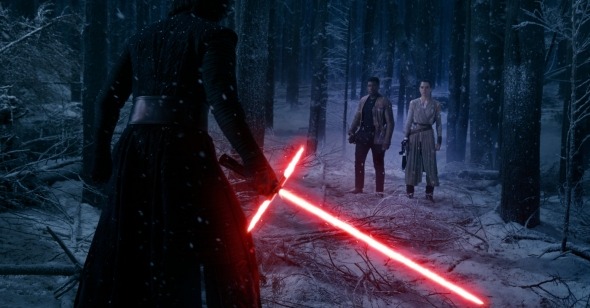Back to the Future
By Eric Hynes
Star Wars: The Force Awakens
Dir. J. J. Abrams, U.S., Twentieth Century Fox
“My friend. How I’ve missed you.”
“We’ll see each other again. I just know it.”
“May the Force be with you.”
This is the era of do-not-fuck-it-up. Ant-Man? It’s fine—at least Peyton Reed didn’t fuck it up. Batman v. Superman? Don’t fuck it up, Zack Snyder, like you did Watchmen. X-Men: Apocalypse? Let’s bring back Bryan Singer because he didn’t fuck up those first few X-Men movies. The first thing art director Nash Dunnigan told a fan-filled crowd at Museum of the Moving Image in advance of a screening of The Peanuts Movie? “Don’t worry, we didn’t screw it up.” Movies are made of proven entities to minimize risk, but that transfers the stakes from making something good to making something that meets the expectations for what it’s supposed to be.
Not fucking it up was assignment number one for the seventh installment of the Star Wars franchise, The Force Awakens, the first without creator George Lucas as director, writer, or showrunner. Director J. J. Abrams was obliged not to fuck up Disney’s $4 billion investment in the property; he was obliged not to fuck it up for the legions of Star Wars aficionados and everyday nostalgists; and he was obliged not to fuck it up for Hollywood in general, which has staked its solvency on blockbusters like Star Wars ever since Star Wars itself debuted in 1977.
Well, he didn’t fuck it up. The reviews have been strong, the fans seem generally happy, and the ship has sailed past $1 billion in worldwide box office receipts at the time of this writing. There are costs to having a mission to not fuck something up, and we’ll get to those costs shortly.
But let’s start with the last three lines of the film, listed above (removed from their context and respective speakers, I assure you they spoil nothing). It wasn’t until these last moments of The Force Awakens that Abrams finally persuaded me that he understands the potential power of the Star Wars saga beyond dominating the marketplace. They’re said in three separate, rapidly successive scenes, by three different characters to three other, nonresponsive companions. Together they locate the heart of the whole enterprise, which has nothing to do with forces of darkness and light, or balance in the universe—all that mumbo jumbo, as the franchise’s most perceptive character is wont to say—but rather lies in its unwavering, beautifully naïve faith in friendship.
Throughout the Star Wars films, friends separate and then come back together, become estranged and reunite. They’re missed, longed for, and embraced. There’s no limit to what friends are willing to do in order to help, save, or find one another. Han forsakes his hard-fought free agency to help Luke overtake the Death Star. Luke abandons his Jedi training to try to save the captive Han and Leia. Luke and Leia both try to spring Han from Jabba’s cryogenic imprisonment. There are variants to these in the prequels among Anakin, Amidala, and Obi-Wan. While family ties in the films are often fraught, needing to be overcome, severed, or vanquished—especially those between sons and fathers—friendships are relatively pure. The erotics of Star Wars are centered in friendship, in the longing for and belonging to elected compadres. It’s friends that meet cute in Star Wars. Friends that embrace on tarmacs. Friends that leaven their magnetic attraction to each other with soft-pedaled put-downs, eye rolls, and caustic asides. The two greatest rapports in all of these films are between the droids C-3PO and R2D2, who are like a junk metal Laurel and Hardy or Bert and Ernie; and Han Solo and his Wookiee copilot Chewbacca, whose interspecies bond is forged on physical ease, soldered trust, and eye-rolling sarcasm, placing them somewhere on the spectrum between Huck and Jim and Mr. and Mrs. Roper. It’s fantastic that the interactions between newcomers Finn (John Boyega) and Poe Dameron (Oscar Isaac) have already been analyzed and celebrated for their homoeroticism, but friendships have always had that energy in these films, leading characters to behave bravely for one another in variably romantic ways.
The Chewie-Han rapport is back in The Force Awakens, with Harrison Ford reunited with the hirsute-costumed Peter Mayhew, very much looking the part of a wizened old couple. At times their exchanges feel lived-in and sincere, and at other times it telegraphs poignancy; the film knows that simply putting those faces together in the same frame will have an emotional effect. It’s a line walked throughout, the success of which can vary according to the viewer and viewing. For my first watch, on opening night amongst a boisterous crowd in Brooklyn, almost everything came off as calculated, corporately determined. A second viewing a week later, among a muted Christmas Eve crowd in suburban New Jersey, went much better. Such that those three last lines resonated beyond the borders of the “Star Wars Universe”—a considerable feat in light of the craft and effort put into establishing a brand-managed echo chamber.

1.“My friend. How I’ve missed you.”
With The Force Awakens, Abrams—along with coscreenwriters Michael Arndt and original trilogy legacy carryover Lawrence Kasdan (scribe on both The Empire Strikes Back and Return of the Jedi)—emulates the movements of previous Star Wars installments so closely it’s as if he’s fearful of getting penalized for falling out of step, as in a game of Guitar Hero. They engineer a viewing experience that can be satisfying and rewarding to spectators familiar with the franchise, if also uncanny to the point of déjà vu. The familiarity extends from shots and gimmicks—an opening salvo of a space vessel eclipsing the sky, a hero traversing a desert landscape with a sun setting in the background, the beeps and gargles of an anthropomorphized robot, a surfeit of wipe cuts—to character, plot, and structure. Though officially a sequel to Return of the Jedi, The Force Awakens often plays like a reboot, much like Ryan Coogler’s recent Creed. There’s a bad guy in a dark mask with a stentorian rumble (Adam Driver’s Kylo Ren), a hotshot fighter pilot in a cool leather jacket (Isaac’s Poe Dameron even steals Han Solo’s lines), and a young and naïve orphan with mysterious, miraculous powers (Daisy Ridley’s Rey) who encounters an adorable little droid harboring a secret that can save the universe. There’s a manmade planet that has the power to destroy other planets, a rescue mission to save a distressed damsel that can take care of herself just fine thank you very much, a father-son showdown on a bridge over a synthetic abyss, and friendships quickly forged before they’re just as quickly strained by separation. The franchise now aims to speak only its own language, such that any unfamiliar notes—uncharacteristic instances of blood, the odd smash zoom—seem off instead of interesting or novel.
That a Star Wars film functions as a recycling machine is hardly out of character, but what began, in Lucas’s first incarnation, as a fantasyland cobbled together from outside sources (Buck Rogers, King Arthur, Akira Kurosawa, Silent Running, Triumph of the Will) now mostly borrows from inside of its own world. There’s still some old Hollywood hokum bleeding through the burgeoning Luke and Han-like friendship between Poe and Finn in The Force Awakens, and there’s generally more original trilogy-grade nostalgia to this installment than in Lucas’s prequels, which, with their enthusiasm for advanced digital effects and realizing their maker’s previously impossible dreams, were more forward focused. I kept waiting for a moment that would bring meaning to this feeling of infinite return, a forceful indicator that there’s philosophical depth to these echoes through generations of trilogies and the viewers who love them. But it never arrived, at least not to my satisfaction. There’s no idea behind the new film’s echoes of the past, outside of making those echoes feel pleasurable—be they Ford’s begrudging summoning of his Solo-era charms, the brassy triumphalism of John Williams’s transporting score, or the perennial joys of robots cavorting with a man in a bear suit. Abrams brings to this film more humanity, and a greater appreciation for his performers, than Lucas managed for all three of the prequels combined. That goes a long way toward making his entertainment click, and furthermore toward making us care. I’m just not sure what we’re caring about, other than the furtherance of Star Wars itself.
For all of its sins, which are very, very, very, very many, The Phantom Menace had a captain, and it was fueled by ideas. Well over a decade after he concluded the original trilogy, Lucas had a vision for what revisiting this universe he had drummed up might look and feel like with the benefit of digital technology, and had a slew of new notions for how to populate and define it. They weren’t particularly good ideas. In fact they were mostly bad, dramatically inert, visually ossified ideas, filled with inexplicable logic, deadening self-seriousness, misunderstandings and mishandlings of what made his own creation compelling, bad writing, worse directing, floundering acting, and endless expository passages about taxes, senates, and genetics. It was like watching a magician listlessly explain what’s awesome about the art of illusion without making magic happen anew. Yet the films emerged from the inside out, and its maker worked passionately to realize them. After abstaining from directing and writing for over two decades, he wrote, directed, produced and financed all three movies. That he became the problem in most estimations—that he shouldn’t have directed, he shouldn’t have written, he should have let other voices and ideas challenge his own—points to a failure in execution, but not in provenance, nor in integrity. That you could blame Lucas for the failings of those movies only proved how much they belonged to him.
By contrast, The Force Awakens belongs to a corporation. It is a product meant to make good on an investment. Disney purchased a property from Lucas, and made a movie related to that property in order to start recouping its outlay. The best way to recoup that outlay was to very carefully and deliberately court and flatter a fan base that has kept the Star Wars brand popular for 38 years and counting; to guarantee that no floppy-eared CGI alien minstrel show will embarrass and shame everyone in sight, that there will be no bogged-down weirdness about midi-chlorians or intergalactic trade agreements, no thespians in bathrobes barely tolerating pantomiming swordplay in front of a green screen (disregarding the fact that those missteps still led to a half-billion box office haul in 1999); to make certain that this new thing is nothing but a sure thing; to make this corporate product at least seem like a public trust—counteracting Lucas’s failure to understand that this is what his creation had evolved into, in effect if not in actuality. There’s no WTF in The Force Awakens because WTF can’t be afforded. It’s smart business, but it’s not an idea—quite the opposite, actually. First comes economics, and then you hired some artists, and then, maybe, you make some art. Any ideas or inspirations come further down the line, in whatever any of the participants might bring to certain aspects of the enterprise. None of this need invalidate what the film winds up being, but it does inform, and to a large degree define it.

2. “We’ll see each other again. I just know it.”
Thus, even as it advances chronologically, this third trilogy begins by cycling backwards to what worked, and what was beloved, previously. (Whereas even as it traveled back to a time before the original trilogy, The Phantom Menace gleefully, and often inexplicably, leapt forward in terms of technology, effects, and density of imagery.) Solo is back. Chewie, Leia, C-3PO, and R2D2 are too. Though Return of the Jedi ended in triumph for the Rebellion, with Darth Vader neutralized and the Emperor extinguished, and the bigger and better Death Star exploded before it even became operational, the new film’s opening crawl informs us that we’re back in cozy underdog territory, with the ascendant First Order rising from the ashes of the Empire, and the rebels back on their heels and scattered throughout the galaxy. And forget about the advancement or retrenchment of armies, or the machinations of coalitions in the Senate, or the spiritual crises of a league of Jedis—the quest narrative of The Force Awakens is simply about finding Luke Skywalker. Missing from the prequels, he’s now the mojo that must be gotten back. The seeker is now the sought.
The closest The Force Awakens comes to a wild card is the character of Finn, the Storm Trooper with a conscience, a character without predecessor that, perhaps not coincidentally, thrums the film to life. The spirit of friendship that is the franchise’s emotional legacy gets pressurized in Finn, whose puppy-esque eagerness to attach to those he meets is well served by Boyega’s eagerness to please. He sells a man-crush on Poe and romantic flutterings with Rey with improbable but convenient speed, flaunting appealing if unsubtle facial work that invites us to feel his emotional highs and lows rather than coolly observe them. (Compare Boyega’s Finn to the telegraphed and yet still remote oscillations of Hayden Christiansen’s Anakin Skywalker in the prequels, a character that ought to have traced a Shakespearean arc but never rose above a flatline.) He bumbles into a Tie Fighter getaway with Poe, crash-lands into Rey’s desert town, earns side-eyes from Han and Chewie, and faces down Kylo Ren using Luke Skywalker’s lightsaber. That Boyega does all of this ingratiatingly, testing but never exhausting our patience, is some kind of feat. His energy, particularly as it’s channeled toward connecting with his co-stars, distinguishes the film.
Meanwhile Ridley’s Rey proves more charismatic and less bratty than Mark Hamill’s Skywalker in the working class wunderkind slot, which is another instance of strategically starting things off at an advanced stage of audience sympathy. Having us warm to Rey over the course of the film, as we did to the disaffected teen-cum-warrior Luke, would be too risky. The cost is that Ridley at first comes off as something of a blank slate—physically proficient, familiarly attractive, comfortingly British. (This might be Abrams’s savviest sleight of hand: making the placing of a female character at the center of this new trilogy seem banal, even expected.) But she shows something else in her two scenes with Driver, who, in a career-defining pivot, brings his A-game to a dress-up pageant (taking a cue from Alex Guinness’s sincerity of purpose in the original). First up is a who’s-zooming-who Force-off while Rey’s strapped to a torture device—the second such scene, following the Force-less Poe coughing up intel to the masked one under duress, both of which echo Vader’s dubious probing of Leia in the original. Quite easily once asked, Kylo removes his mask to expose flowing locks and liquefied eyes, and tries to use the Force to get Rey to reveal the big secret—the missing section of a map that will lead to Skywalker’s whereabouts (not joking)—but she resists. Abrams lets the scene play a bit, lets them share the frame (a rarity in a film that favors shot/reverse shot interplay) as they grunt and seethe and play tug of war with each other’s inner thoughts. There’s a queasy sexual chemistry between the strapped-down heroine and the handsome, Gargamel-cloaked villain, which seems to arise not from a plot imperative but from the electricity passed between two compelling people in proximity.
That chemistry is resumed during an epic lightsaber battle in the woods, the film’s most dramatically compacted scene as well as its most visually inspired. With a shocking (though not really) turn of events still fresh in our minds, and Finn at least temporarily toppled, Rey discovers her powers in time to spar with Kylo, resuming their battle of positive-negative spiritual forces and undulating sexual tension. They chase each other around the woods, niftily felling trees with their flaming weapons like slow motion warriors in a Zhang Yimou film, and again stare at each other, this time over crossed and crackling sabers, air-parrying undefined heat. It feels like something, and it also looks like something—in that it doesn’t mean to overtly resemble anything we’ve seen before in the franchise. Abrams had an idea here, or at least an out-of-bounds reference, and it shows.
As is customary with the franchise, there’s a bit of business everywhere you look—new planets, upgraded gadgets, different monsters, things to puzzle over and surmise, bit characters to fetishize and commodify. My favorite of all these was Maz Kanata, voiced by a well-disguised Lupita Nyong'o, a diminutive, prune-faced, crater-eyed creature installed in some kind of ancient temple-transit hub-Reggae club who slows things down to take a good look at everyone, correctly identifying Rey as someone with special powers and a story to tell. It’s in this passage that Rey inexplicably finds Luke’s lightsaber in a basement trunk, causing her to have canted angle flashbacks to traumatic childhood moments that briefly but gloriously evoke the studio-set artificiality of Vincente Minnelli dream sequences, with Ridley as a disoriented Gene Kelly lost in a made-up world inside of a made-up world.

3. “May the Force be with you.”
Strangely, for all of the film’s slavishness to the original, Abrams seems subtly impatient with, and at times even cursory about, those obligations. The dramatic reunion of Han and Leia (Carrie Fisher), now a general, gets comically defused by an intervening C-3PO, and then their private, narratively crucial conversation about the troubled fate of their progeny not only lacks visual or tonal depth, it’s even shoddily performed by old pros Fisher and Ford. It brought to mind Tim Burton’s petulantly botched handling of Vickie Vale’s invasion of the Bat Cave, and discovery of Bruce Wayne’s double life in Batman, which just kind of happens. Oh, you wanted this? Fine, here’s this. At the risk of giving too much away, that chilliness toward inherited characters extends to a death scene, after which the emotional impact on a newcomer is valued above that of a dearest old friend. It’s as if the film is trying to use those old friends as a way of transitioning us into making new ones. Han takes a liking to Rey, as does Leia, and they both also make sure to validate Finn. Poe, played by the more established Isaac, seems already part of the fold, accepted as the top pilot in the Rebellion and free to offer advice to General Leia in a strategy session.
Abrams’s seeming impatience to move things into new territory simultaneously confirms the branding requirements of nostalgia placed upon him, and hints at the potential, as well as the need, for moving forward with a bit less baggage. For if the whole shebang is dependent upon a story made up of other stories cooked up four decades ago, featuring actors as characters we all know they’ve outgrown—just think of the lives that Carrie Fisher has lived since she tossed away that slave girl bikini in 1983—it will never have any value beyond itself. New ideas have to come rushing in along with the promising new faces introduced by The Force Awakens. Its heart finds its right place in those last few moments, but the jury’s still out on the head, as well as the soul, of this resuscitated Star Wars.
